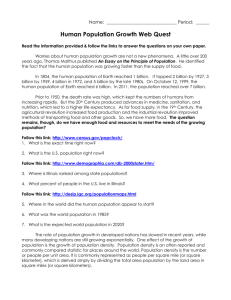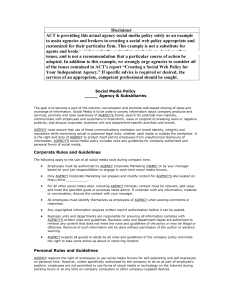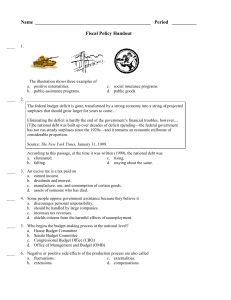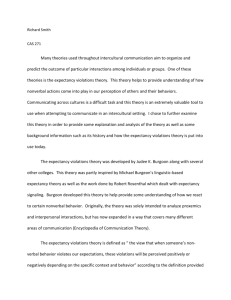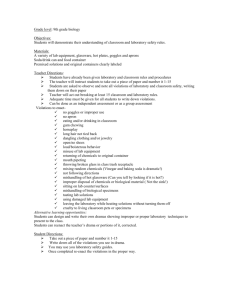File - Jacob English
advertisement
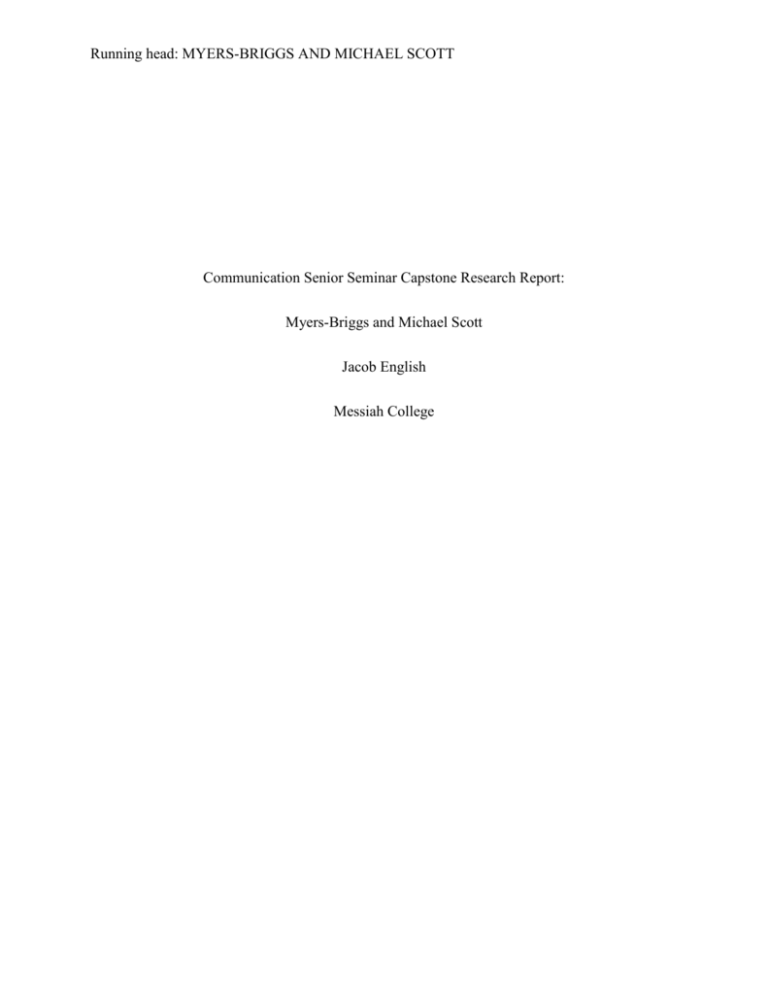
Running head: MYERS-BRIGGS AND MICHAEL SCOTT Communication Senior Seminar Capstone Research Report: Myers-Briggs and Michael Scott Jacob English Messiah College MYERS-BRIGGS AND MICHAEL SCOTT English 1 Introduction & Literature Review “Would I rather be feared or loved? Easy, both. I want people to be afraid of how much they love me” (Season 2 Episode 6). This is one of the many “words of wisdom” from Dunder Mifflin’s Regional Manager, Michael Scott. NBC’s The Office is known as one of the most noteworthy shows to be on television. The Office was created by Ricky Gervais and Stephen Merchant as a remake of the 2001 BBC series. The mockumentary style sitcom (fictional documentary) takes place in a paper distribution company in Scranton Pennsylvania. Steve Carrel plays Michael Scott, an ignorant and bizarre boss who strives to have a strong relationship with his co-workers and finds himself getting into ridiculous situations. The Office impacts American society through the fact that it lead to the creation of similar shows (Parks and Recreation & Modern Family), and because it acts as a commentary on social norms. The show holds a great deal of unique qualities which has contributed to its success. One of these qualities is the incorporation of expectancy violations as a method for humor. However, over discourse and discussion it has been found that some people do not like this aspect of the show. The goal of this study explain why some people like the expectancy violations and why others do not. Expectancy Violations Theory was proposed by Judee Burgoon (Griffin, 2012). It is an objective theory under the Socio-psychological tradition. To begin, Burgoon suggests that every person has their own level of expectancies. “As a core construct of the theory, expectancy is defined as an enduring pattern of anticipated verbal and nonverbal behaviors” (Kim, 2014, p.140). These expectancies come from the context of the situation, the type of relationship that we have with the other person, and the communicator characteristics of the other as well. According to Elizabeth Cohen (2010), “Deviations from these expectations create expectancy violations.” Once a violation occurs, the violated has to interpret the valence of the violation and the reward valence of how to react. In other words, one must determine whether the violation is positive or negative while also determining whether maintaining that relationship with the violator holds more positive or negative consequences (Griffin, 2012). The Office depicts the effect of expectancy violations through the use of comedy vérité. This is connected to the concept of cinema vérité which is referring to the power that the camera can have to cause people to behave in an atypical manner (Mills, 2004). The documentary style of sitcom allows the characters to interact with the camera. Interviews are the most obvious, but they also interact with the camera as they are being observed. This style additionally allows nonverbals to be a lot more obvious. Many times Jim Halpert looks at the camera anytime something inappropriate or ridiculous happens. This new style of using the camera is what contributes to the shows humor by depicting characters during times they are aware of being filmed and times they are not aware (Mills, 2004). However, this does not explain why some viewers may not like this aspect of the show. Studies identified different reactions to given expectancy violations. However, these differences are more focused on kind of relationship that is shared with another person, rather than an individual’s reaction. One experiment describes participants being placed in friend and stranger dyads to conduct discussions. Throughout discussion, one member would either increase or decrease immediacy. Researchers found when members decreased immediacy, both strangers and friends were seen as less interested. However, when immediacy was increased, only friends were seen as positive where the strangers were seen as violating nonverbal expectancies MYERS-BRIGGS AND MICHAEL SCOTT English 2 (Burgoon and Hale, 1988). This is evidence that the type of relationship is an important factor when considering how one responds to expectancy violations. Likewise, Cohen’s study on expectancy violations in relationships with friends and media figures continues to support an emphasis on types of relationships in regards to how people respond to expectancy violations (2010). To clarify, these media figures are real people displayed on the media such as athletes, celebrities, and actors/actresses. Cohen argued, “each relationship is founded on different expectations, a violation in one relationship will not necessarily be considered offensive in another” (Cohen, 2010, p. 99). In the study, Participants rated how they would react to different violations depending on whether it was committed by a friend or a media figure. Examples of violations included, “I notice that this person is disrespectful or insulting to people that they don’t feel personally attached to,” and “This person begins making offensive or inappropriate comments” (Cohen, 2010, p. 103). Results found that that less tolerance was expressed to media figures who committed a violation over friends who committed the same violation. This continues to show the importance of a relationship in regards to responses of expectancy violations. While many argue the type of relationship is important to how others respond to expectancy violations, there is also evidence that personality type could be another factor. Susan Opt and Donald Loffredo (2000) conducted research on a similar topic. They questioned if personality type affected communication apprehension through the use of the Myers-Briggs Type Indicator (MTBI). This method determines whether people perceive by sense or intuition, and whether people judge by thinking or feeling. It additionally identifies if people are introverted or extraverted as well as whether perceiving or judging is the dominant processes in guiding individual’s behavior. Opt and Loffredo used a self-scorable MTBI form for participants to fill out. They additional used a Personal Report of Communication Apprehension form. Communication apprehension is the level of anxiety or uncomfortableness someone feels in different situations. Opt and Loffredo found that Introverts and Feelers scored significantly higher on communication apprehension compared to Extroverts and Thinkers (Opt & Loffredo, 2000). This research can potentially be applied to expectancy violations because people experience communication apprehension when expectancy violations are committed. Given the research above, the mockumentary style of the Office successfully depicts a wide variety non-verbal behavior which allows expectancy violations to become prevalent for the use of comedic effect. However, prior discourse and discussion claims this method for comedy is the reason why some like the show and why others dislike it. This suggests that individuals are responding to the expectancy violations differently which determines whether they like the show or not. Previous research on expectancy violations has been limited how people react to violations depending on the relationship as opposed to personality causing a gap in the research. However, Opt and Loffredo’s study provides some support for a possible connection between personality types and responses to expectancy violations. In order to close the gap, this study aims to answer, “How do different personality types respond to the expectancy violations incorporated in the Office?” MYERS-BRIGGS AND MICHAEL SCOTT English 3 Methods Participants Participants were recruited by the means of cluster sampling. Participants were undergraduate students at Messiah College who were enrolled in Communication courses of various levels. A wide range of constituencies was reached from general education courses and also upper level courses. Students were introduced the research topic and asked to sign up for one of three evening sessions to take a survey. A total of 40 students participated in the survey, consisting of 22 females and 18 males. Every participant was informed of the possible benefits of taking the survey which consisted of them gaining experience on how different personality types interact and react to others. They were also informed of the consequences which was the possibility of feeling awkward or uncomfortable. Each participant took part in the survey voluntarily and signed an informed consent form. Procedure This study used quantitative methods in order explore the research question presented above. A self-administered questionnaire was developed to discover if a relationship exists between personality type and responses to expectancy violations in the Office. The process consisted of participants taking an online Myers-Briggs personality test, watching a short video clip of the Office through the use of Netflix, and then answering a few questions in response to the video. This study chose to use 16personalities.com for the online personality test because it provided a test that was brief but also accurate and consistent. Because of the complicated process, in person surveys were more preferable than online surveys. The study took place in a computer lab in one of the academic buildings. Participants recorded the results of their personality test on the survey (i.e. INTJ), they were shown a brief video clip from the Office. The clip selected was a scene from Season 3 Episode 22, “Women’s Appreciation.” In the scene, one of the female employees, Phyllis, walked into the office and expressed that a man flashed her. The manager, Michael Scott, then walks in and begins to make a joke out of the situation. Another employee walks in, Toby, and discourages Michael from making jokes. Michael then responds defensively to Toby and accuses him of being the flasher. He then shouts, “Let’s see your penis!” leaving an awkward silence in the office. The scene is a perfect example of the expectancy violations incorporated into the show. This particular scene is not on YouTube, which explains the requirement for Netflix. After watching the clip, participants responded to a few questions. These questions included: 1. On a scale of 1-10, 1 being not very uncomfortable and 10 being very uncomfortable, how uncomfortable did you feel after watching this scene? 2. On a scale of 1-10, 1 being not very entertaining and 10 being very entertaining, how entertaining did you find the scene to be? 3. On a scale of 1-10, 1 being not at all humorous and 10 being very humorous, how humorous did you find the expectancy violations in this scene to be? These questions aimed to measure responses to the expectancy violations incorporated in the scene, predicting that the more uncomfortable someone felt the less entertaining they would MYERS-BRIGGS AND MICHAEL SCOTT English 4 find the scene to be. This suggests an existing negative correlation between response to expectancy violation and liking of the show. Participants were also asked questions to describe their familiarity and current opinion of the Office in order to explore the type relationship they had with the show. After collecting the data, it was inputted onto Survey Monkey, an online survey program. This simplified the analysis process and allowed results to be compared easily. Based off of the research in the literature review, this study predicted: 1. Extroverts over Introverts will respond more positively to the expectancy violations in the Office and be more liking to find the show entertaining. 2. Thinkers over Feelers will respond more positively to the expectancy violations in the Office and be more likely to find the show entertaining. 3. Extroverted Thinkers over Introverted Feelers will respond more positively to the expectancy violations in the Office and be more likely to find the show entertaining. Results After collecting the data, responses were placed into four categories based off of the personality test scores: Introverted Thinkers (IT’s), Extroverted Thinkers (ET’s), Extroverted Feelers (EF’s), and Introverted Feelers (IF’s). Results consisted of 3 IT’s, 6 ET’s, 23 EF’s, and 8 IF’s. This study found 7 males and 2 females to be Thinkers and 12 males and 19 females to be Feelers. This sample size clearly contained imbalances in personality types which impacts the remaining results. Taking note of this, the predictions presented above have a slight chance of being supported by the results, but not near significant. After participants watched the video clip from the Office, they provided responses stating how they felt about the scene and the expectancy violations in the scene. Referencing the charts below, there are several pieces of data to make note of. When asked, “How uncomfortable did you feel after watching this scene?” IF’s scored the highest in uncomfortableness with a mean of 5.38. ET’s scored the highest mean (8.33) when asked, “How entertaining did you find the scene to be?” Additionally, Thinkers scored higher means than Feelers when asked, “How humorous did you find the expectancy violations to be?” However, even though these results slightly support the predictions, the scores are not different enough to fully support them. All of the means are fairly close together and the standard deviations are too large to support significant differences. Furthermore, ET’s scored the second highest mean in uncomfortableness (Chart A), and IF’s scored the second highest mean in entertainment rating (Chart B). Since they both scored high in uncomfortableness and entertainment rating/liking, this suggests that there is not a correlation between uncomfortableness and liking. Chart D displays a scatter plot comparing the responses of these two questions and clearly there is no pattern or correlation between them. This implies there may be another factor which affects entertainment rating/liking. Participants additionally answered, “On a scale of 1-10, 1 being very unfamiliar and 10 being very familiar, how familiar are you with NBC’s the Office?” and “On a scale of 1-10, 1 being not very entertaining and 10 being very entertaining, how entertaining do you find NBC’s the Office to be?” The responses to these two questions were compared on a scatter plot (Chart E), which revealed pattern resembling a positive correlation. Results also found a positive correlative pattern between familiarity and the entertainment rating of the scene used for the MYERS-BRIGGS AND MICHAEL SCOTT English 5 study as well (Chart F). These findings continue to provide evidence for responses to expectancy violations to be dependent on the type of relationship. Chart A. How uncomfortable did you feel after watching this scene? Basic Statistics Minimum Maximum Median Mean Standard Deviation Q3: IT'S (A) 1.00 7.00 1.00 3.00 2.83 1.00 10.00 5.50 5.17 3.34 1.00 10.00 3.00 4.04 2.42 1.00 8.00 5.50 5.38 2.45 Q3: ET'S (B) Q3: EF'S (C) Q3: IF'S (D) Chart B. How entertaining did you find the scene to be? Basic Statistics Minimum Maximum Median Mean Standard Deviation Q3: IT'S (A) 3.00 9.00 9.00 7.00 2.83 5.00 10.00 8.50 8.33 1.70 3.00 10.00 8.00 7.30 2.16 6.00 10.00 8.00 8.25 1.09 Q3: ET'S (B) Q3: EF'S (C) Q3: IF'S (D) MYERS-BRIGGS AND MICHAEL SCOTT English 6 Chart C. How humorous did you find the expectancy violations to be? Basic Statistics Minimum Maximum Median Mean Standard Deviation Q3: IT'S (A) 3.00 10.00 10.00 7.67 3.30 5.00 10.00 8.50 8.17 1.77 1.00 10.00 7.00 6.26 2.52 3.00 10.00 7.50 7.25 2.17 Q3: ET'S (B) Q3: EF'S (C) Q3: IF'S (D) Chart D. Uncomfortableness and Entertainment Rating Entertainment Rating 12 10 8 6 4 2 0 0 2 4 6 Uncomfortableness 8 10 12 MYERS-BRIGGS AND MICHAEL SCOTT English 7 Chart E. Entertainment and Familiarity 12 10 Entertaining 8 6 4 2 0 0 2 4 6 8 10 12 Familiarity Chart F. Familiarity and Liking of the Scene 12 Entertainment Rating 10 8 6 4 2 0 0 2 4 6 Familiarity 8 10 12 MYERS-BRIGGS AND MICHAEL SCOTT English 8 Discussion The results of this study revealed a minute amount support of an existing relationship between personality type and responses to expectancy violations in the Office. While ET’s scored highest on entertainment rating, IF’s scored highest on uncomfortableness, and Thinkers scored highest on humorous rating, the scores did not show signs of significant differences to make any implications of an existing relationship. This could be attributed to several limiting factors of the study. The sample size was small and unbalanced. Only 3 IT’s compared to 23 EF’s participated in the study, so not enough responses were collected from IT’s as well as the other two personality types. With a larger sample size, perhaps the data would have been more balanced. Furthermore, a larger sample size would be more revealing of a possible relationship between personality type and responses to expectancy violations in the Office. The larger the sample size, the more accurate it is to the general population and significant differences in data become clearer as well. Another limiting factor was the decision to use Quantitative methods. Quantitative involves a great amount of trial and error with numerical data. If the results fully supported the predictions, this method would have been a fantastic choice. However, because this study did not produce the predicted results, it leaves one wondering what other factors could be involved. All that is left to do is guess why and try again. Results exhibited no relationship between uncomfortableness and entertainment rating/liking. Some responses stated that they felt very uncomfortable (10) but also found the scene to be very entertaining (10). This implies that viewers may respond to the expectancy violations in the show differently but even if they feel uncomfortable in response to the violations, it does not automatically imply that they do not think the show is funny. So this leads one to believe there are other factors impacting whether someone likes or dislikes the Office. One suggested factor that affects the liking or disliking of the Office is familiarity. Survey results confirmed a positive correlation between familiarity and general entertainment rating as well as entertainment rating to the specific scene. As one becomes more familiar with the Office, the more entertaining they find it. Viewers become accustomed to characters on the show and form “relationships” with them. The implications of this correlation supports prior research conducted in the literature review above. Studies by Cohen (2010), and Burgoon & Hale (1988), argue that people respond to expectancy violations base off of the type of relationship they have with a given person. Cohen claimed that more leniency is shown to friends committing expectancy violations over media figures because of the strength of the relationship. Burgoon and Hale state that expectancy violations are view more positively when committed by a friend as opposed to a stranger. The same can be argued with the Office. If someone is more familiar with the show they are more likely to have a stronger “relationship” with the characters and be more likely to see the expectancy violations as positive or show more leniency toward them. Furthermore, people who are less familiar would not be as lenient and attribute a negative valence to the violations. As a result, they do not give the show a second look. There are several suggestions for continual exploration of this topic. First, a larger and more balanced sample size should be the primary priority if this study was to be done again. Perhaps it would be more revealing of a relationship between personality type and responses to expectancy violations in the Office. On the contrary, qualitative methods may provide more information if someone wanted to take a different approach. Perhaps focus groups or interviews MYERS-BRIGGS AND MICHAEL SCOTT English 9 could expose information that is missing. Finally, there is a lot that can be explored with the relationship to familiarity and liking. For example, one could test reactions to the expectancy violations in the Office before and after prolonged exposure to the show and compare the results to find further support for the relationship. In conclusion, this study opens the door for future research to be done on expectancy violations and how different personality types respond to them in real life. Through the continuance of research, people will have the ability to gain a greater understanding of how others interact and communicate, so that they themselves may improve their communication skills. MYERS-BRIGGS AND MICHAEL SCOTT English 10 References 16Personalities - Free personality test, type descriptions ... (2015). Retrieved May 4, 2015, from http://www.16personalities.com/ Burgoon, J., & Hale, J. (1988). Nonverbal Expectancy Violations: Model Elaboration And Application To Immediacy Behaviors. Communication Monographs, 55, 58-79. Cohen, E. (2010). Expectancy Violations In Relationships With Friends And Media Figures. Communication Research Reports, 27(2), 97-111. Griffin, E. (2012). A first look at communication theory (6th ed.). Boston: McGraw-Hill. Mills, B. (2004). Comedy Verite: Contemporary Sitcom Form. Screen, 45(1), 63-78. Netflix - Watch TV Shows Online, Watch Movies Online. (2015). Retrieved May 4, 2015. Opt, S., & Loffredo, D. (2000). Rethinking Communication Apprehension: A Myers-Briggs Perspective. The Journal of Psychology, 134(5), 556-570. SurveyMonkey. (2015). Retrieved May 4, 2015, from https://www.surveymonkey.com/user/sign-in/

